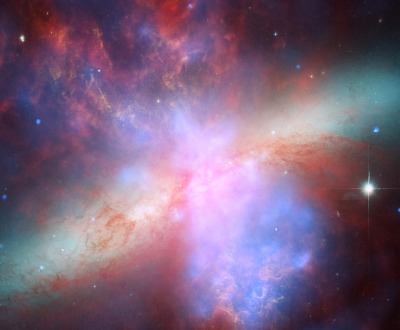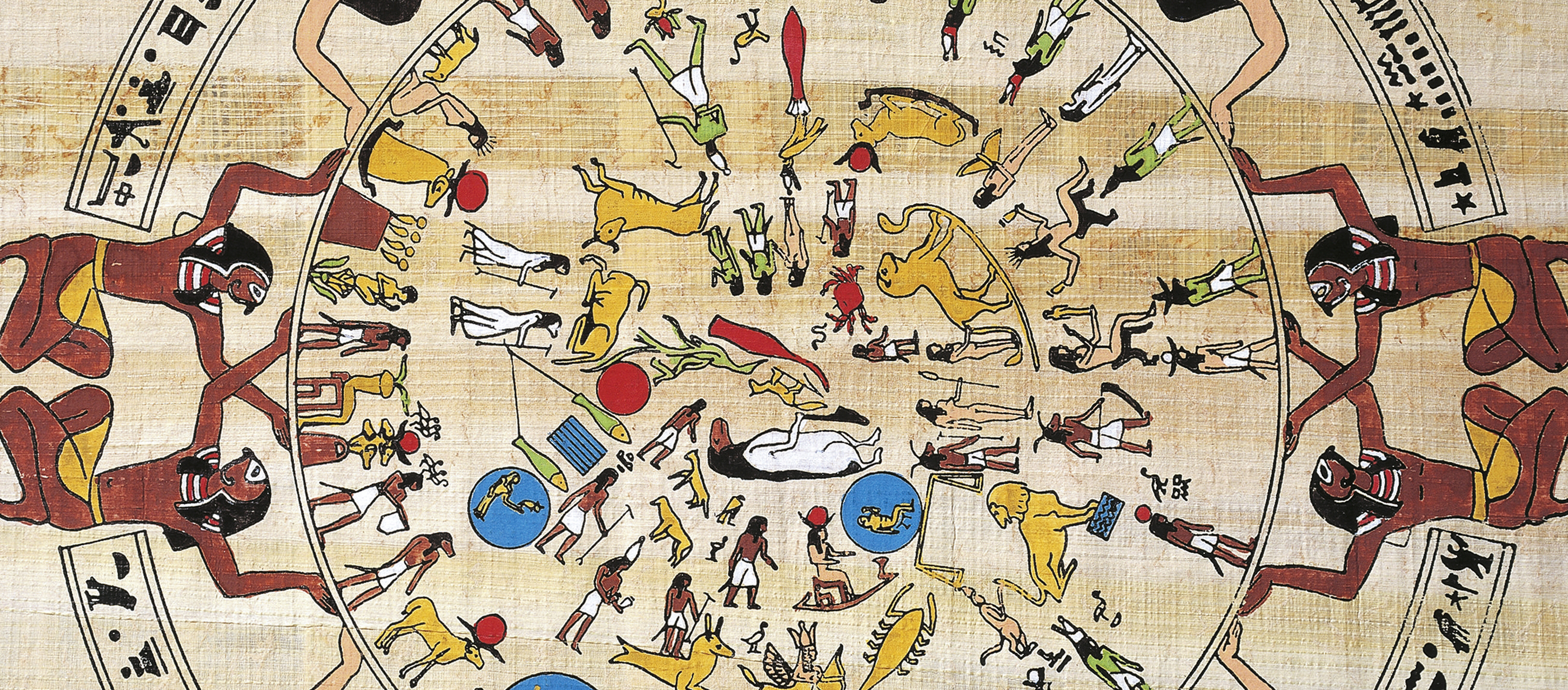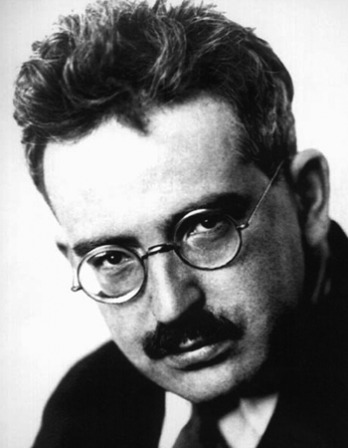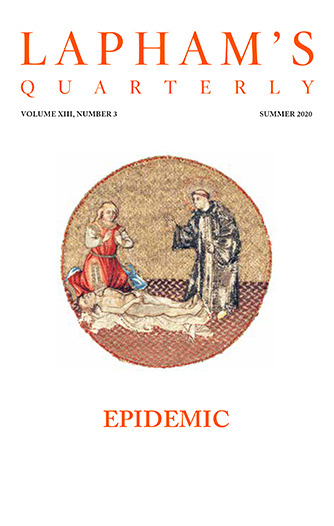In time history must become a fairy tale—it will become again what it was in the beginning.
—Novalis, 1798The Grand Illusion
Does time have a future? Yes, but how much of a future depends on what the ultimate fate of the cosmos turns out to be.
By Jim Holt

Starburst galaxy M82, photograph by NASA’s Chandra X-ray Observatory, 2008. NASA, Flickr Commons.
Audio brought to you by Curio, a Lapham’s Quarterly partner
Isaac Newton had a peculiar notion of time. He saw it as a sort of cosmic grandfather clock, one that hovered over the rest of nature in blithe autonomy. And he believed that time advanced at a smooth and constant rate from past to future. “Absolute, true, mathematical time, of itself, and from its own nature, flows equably without relation to anything external,” Newton declared at the beginning of his Principia. To those caught up in the temporal flux of daily life, this seems like arrant nonsense. Time does not strike us as transcendent and mathematical; rather, it is something intimate and subjective. Nor does it proceed at a stately and unvarying pace. We know that time has different tempos. In the run-up to New Year’s Eve, for instance, time positively flies. Then, in January and February, it slows to a miserable crawl. Moreover, time moves faster for some of us than for others. Old people are being rushed forward into the future at a cruelly rapid clip. When you’re an adult, as Fran Lebowitz once observed, Christmas seems to come every five minutes. For little children, however, time goes quite slowly. Owing to the endless novelty of a child’s experience, a single summer can stretch out into an eternity.
One way researchers have tried to measure the subjective flow of time is by asking people of different ages to estimate when a certain amount of time has gone by. People in their early twenties tend to be quite accurate in judging when three minutes had elapsed, typically being off by no more than three seconds. Those in their sixties, by contrast, overshot the mark by forty seconds; in other words, what was actually three minutes and forty seconds seemed like only three minutes to them. Seniors are internally slow tickers, so for them actual clocks seem to tick too fast. This can have its advantages: at a John Cage concert, it is the old people who are relieved that the composition 4'33" is over so soon.
The river of time may have its rapids and its calmer stretches, but one thing would seem to be certain: it carries all of us, willy-nilly, in its flow. Irresistibly, irreversibly, we are being borne toward our deaths at the stark rate of one second per second. As the past slips out of existence behind us, the future, once unknown and mysterious, assumes its banal reality before us as it yields to the ever-hurrying “now.”
But this sense of flow is a monstrous illusion—so says contemporary physics. And Newton was as much a victim of this illusion as the rest of us are. It was
Albert Einstein who initiated the revolution in our understanding of time. In 1905, Einstein proved that time, as it had been understood by physicist and plain man alike, was a fiction. Our idea of time, Einstein realized, is abstracted from our experience with rhythmic phenomena: heartbeats, planetary rotations and revolutions, the swinging of pendulums, the ticking of clocks. Time judgments always come down to judgments of what happens at the same time—of simultaneity. “If, for instance, I say, ‘That train arrives here at seven o’clock,’ I mean something like this: ‘The pointing of the small hand of my watch to seven and the arrival of the train are simultaneous events,’” Einstein wrote. If the events in question are distant from each other, judgments of simultaneity can be made only by sending light signals back and forth. Einstein proved that whether an observer deems two events at different locations to be happening “at the same time” depends on his state of motion. Suppose, for example, that Jones is walking uptown on Fifth Avenue and Smith is walking downtown. Their relative motion results in a discrepancy of several days in what they would judge to be happening “now” in the Andromeda galaxy at the moment they pass each other on the sidewalk. For Smith, the space fleet launched to destroy life on earth is already on its way; for Jones, the Andromedan council of tyrants has not even decided whether to send the fleet.

Four Years out of a Death Row Sentence (Forest), from the series Black Is the Day, Black Is the Night, by Amy Elkins, 2011. © Amy Elkins, courtesy of the artist.
What Einstein had shown was that there is no universal “now.” Whether two events are simultaneous is relative to the observer. And once simultaneity goes by the board, the very division of moments into “past,” “present,” and “future” becomes meaningless. Events judged to be in the past by one observer may still lie in the future of another; therefore, past and present must be equally definite, equally “real.” In place of the fleeting present, we are left with a vast frozen timescape—a four-dimensional “block universe.” Over here, you are being born; over there, you are celebrating the turn of the millennium; and over yonder, you’ve been dead for a while. Nothing is “flowing” from one event to another. As the mathematician Hermann Weyl memorably put it, “The objective world simply is; it does not happen.”
Einstein, through his theory of relativity, furnished a scientific justification for a philosophical view of time that goes back to Spinoza, to St. Augustine, even to Parmenides—one that has been dubbed “eternalism.” Time, according to this view, belongs to the realm of appearance, not reality. The only objective way to see the universe is as God sees it: sub specie aeternitatis. We should all be like William Blake and say, “I see the past, present, and future, existing all at once/Before me.”
The revolution in our understanding of time that Einstein initiated was pushed to a more radical extreme by his close friend (and fellow eccentric) Kurt Gödel. Gödel is often considered the greatest logician of the twentieth century. He is most famous for his “incompleteness theorems,” which showed that arithmetic was, in an interesting sense, beyond the reach of logical provability; but he also dabbled in theoretical physics. Both Gödel and Einstein left Europe because of the Nazis (although Gödel was not Jewish), and both ended up at the Institute for Advanced Study in Princeton, New Jersey. The two men liked nothing better than to stroll around Princeton together trading ideas. In 1949, on the occasion of Einstein’s seventieth birthday, Gödel presented him with an unexpected gift: a proof of the nonexistence of time. And this was not a mere verbal proof, of the sort that philosophers like Parmenides, Immanuel Kant, and J.M.E. McTaggart had come up with over the centuries; it was a rigorous mathematical proof. Playing with Einstein’s own equations of general relativity, Gödel found a novel solution that corresponded to a universe with closed timelike loops. A resident of such a universe, by taking a sufficiently long round trip in a rocket ship, could travel back into his own past. Einstein was not entirely pleased with Gödel’s hypothetical universe; indeed, he admitted to being “disturbed” that his equations of relativity permitted something as Alice in Wonderland–like as spatial paths that looped backward in time. Gödel himself was delighted by his discovery, since he found the whole idea of time to be painfully mysterious. If time travel is possible, he submitted, then time itself is impossible. A past that can be revisited has not really passed. So, Gödel concluded, time does not exist.
Unlike Gödel, Einstein could never quite liberate himself from the grip of time. “To those of us who believe in physics,” he wrote in 1955 to the family of a friend who had recently died, “this separation between past, present, and future is only an illusion, if a stubborn one.” When his own turn came, a few weeks later, Einstein said, “It is time to go.”
Over the decades since Einstein’s death, physics has subjected our everyday notion of time to still more radical dislocations. The frozen timescape of relativity theory has been revealed to have gaping holes in it: black holes. That is because time is “warped” by gravity. The stronger the gravitational field, the slower the clock hands creep. If you live in a ground-floor apartment, you age a trifle less rapidly than your neighbor in the penthouse. The effect would be a lot more noticeable if you got sucked into a black hole, where the gravitational warpage of time is infinite. Quite literally, black holes are gateways to the end of time: to Nowhen.
If time behaves dodgily around black holes, it may vanish altogether at the tiniest of scales, where the fabric of space-time dissolves into a “quantum foam” in which events have no determinate temporal order. Temporal matters are even stranger if we look back at the Big Bang, the cataclysmic event that ushered our universe into existence—and not just the universe, but also its space-time container. We all want to ask: What the heck was going on just before the Big Bang? But that question is nonsensical. So, at any rate, we are told by
Stephen Hawking in A Brief History of Time. Invoking what he calls “imaginary time”—a notion that has been known to puzzle even his fellow physicists—Hawking says that asking what came before the Big Bang is as silly as asking what’s north of the North Pole. The answer, of course, is nothing.
Does time have a future? Yes, but how much of a future depends on what the ultimate fate of the cosmos turns out to be. The possibilities come down to Robert Frost’s choice: fire or ice? Ever since its birth in the Big Bang, some 13.82 billion years ago, the universe has been expanding. If this expansion continues forever, the universe will end in ice, at least metaphorically speaking. The stars will burn out; black holes will evaporate; atoms and their subatomic constituents will decay. In the deep future, the remaining particles (mainly photons and neutrinos) will spread out into the void, becoming so distant from one another that they will cease to interact. Space will become empty except for the merest hint of “vacuum energy.” Yet in this future wasteland of near nothingness, time will go on; random events will continue to occur; things will “fluctuate” into existence, thanks to the magic of quantum uncertainty, only to disappear again into the void. Most of these future ephemera will be single particles, like electrons and protons. But every once in a while—a very great while—more complicated structures will spontaneously wink into being; say, a human brain. Indeed, in the fullness of time, quantum physics could allow for an infinite number of such disembodied brains, stocked with (false) memories, that will appear and disappear. In the scientific literature, these sad and evanescent entities are called “Boltzmann brains” (after Ludwig Boltzmann, one of the pioneers of modern thermodynamics). One such deep-future Boltzmann brain would be identical to your own brain as it is constituted at this very moment. Thus, in some inconceivably distant epoch, your current state of consciousness would be recreated out of the void, only to be extinguished an instant later—not, perhaps, the kind of resurrection you were hoping for.
All that could be true (says current physics) provided the universe continues to expand eternally, growing ever emptier and darker and colder: a scenario that might be called the Big Chill. But there is another possible cosmic fate. By and by, at some point in the far future, the expansion that the universe is currently undergoing might be arrested—maybe by gravity, maybe by some force that is currently unknown. Then all the hundreds of billions of galaxies will begin to collapse back on themselves, eventually coming together in a fiery all-annihilating implosion: the Big Crunch. Just as the Big Bang brought time into existence, the Big Crunch would bring it to an end. Or would it? Some cosmic optimists have argued that in the final moments before such a Big Crunch an infinite amount of energy would be released. This energy, the optimists say, could be harnessed by our deep-future descendants to power an infinite amount of computation, giving rise to an infinite number of thoughts. Since these thoughts would unfold at a faster and faster pace, subjective time would seem to go on forever, even though objective time was about to come to an end. The split second before the Big Crunch would thus be like a child’s endless summer: a virtual eternity.
Virtual eternity, gateways to Nowhen, the unreality of time…Do any of these lotus-eater ideas really hit us where we live, in the lifeworld? Probably not. Like Einstein himself, we are stubbornly in thrall to our temporal illusions. We cannot help feeling ourselves to be slaves to one part of the timescape (the past) and hostages to another part (the future). Nor can we help feeling that we are quite literally running out of time. Arthur Eddington, one of the first physicists to grasp Einstein’s relativity theory, declared that our intuitive sense of time’s passage is so powerful that it must correspond to something in the objective world. If science cannot get a purchase on it, one might say: Well, so much the worse for science!

Replica of the zodiac ceiling in the Temple of Hathor, Dandarah, Egypt, papyrus, c. 320 BC. (Papyrus Museum, Cairo, Egypt / De Agostini Picture Library, Bridgeman Images)
What science can tell us something about is the psychology of time’s passage. Our conscious now—what William James dubbed the “specious present”—is actually an interval of about three seconds. That is the span over which our brains knit up arriving sense data into a unified experience. It is also pretty clear that the nature of memory has something to do with the feeling that we are moving in time. The past and the future might be equally real, but—for reasons traceable, oddly enough, to the second law of thermodynamics—we cannot “remember” events in the future, only ones in the past. Memories accumulate in one temporal direction and not in the other. This seems to explain the psychological arrow of time. It does not, unfortunately, explain why that arrow seems to fly.
If all of this leaves you utterly bewildered about time, you are in eminent company. John Archibald Wheeler, one of the great physicists of the twentieth century, took to quoting this in a scientific paper: “Time is nature’s way to keep everything from happening all at once.” In a footnote, Wheeler writes that he discovered this quote among graffiti in the men’s room at the Pecan Street Café in Austin, Texas. That such an eminent thinker would resort to quoting from a men’s-room wall isn’t surprising if you consider the contemporary free-for-all among physicists and philosophers and philosophers of physics over the nature of time. Some maintain that time is a basic ingredient of the universe; others say, no, it emerges from deeper features of physical reality. Some insist that time has a built-in direction; others deny this. (Stephen Hawking once claimed that time could eventually reverse itself and run backward, only to realize later that there had been a mistake in his calculations.) Most physicists and philosophers today agree with Einstein that time’s passage is an illusion; they are eternalists. But a minority—who call themselves “presentists”—think that now is a special moment that really advances, like a little light moving along the line of history; this would still be true, they believe, even if there were no observers like us in the universe.
If there is one proposition about time that all scientifically inclined thinkers can agree on, it might be one due to the nonscientist Hector Berlioz, who is reputed to have quipped, “Time is a great teacher, but unfortunately it kills all its pupils.”
Portions of this essay previously appeared in “Time Passages: How Long Does It Take for a Second to Go By?” from Lingua Franca, July–August 1999.



